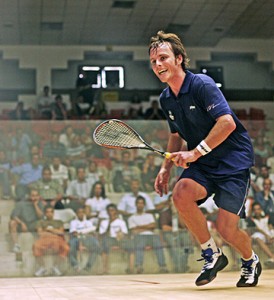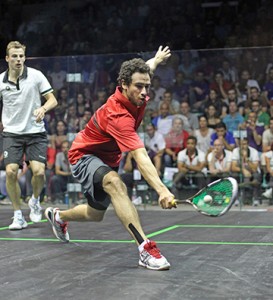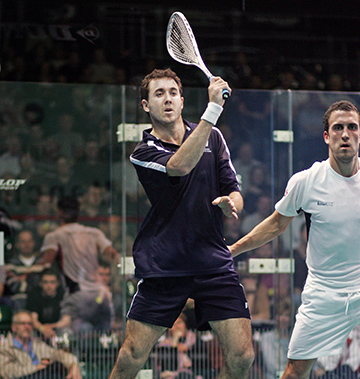By Peter Nicol
Using the correct length of swing is essential for both shot execution and deception. Which swing to use and when is the issue that is constantly evolving throughout a match because it depends on so many factors. Understanding what you are capable of and the best possible swing length to use in different situations is an invaluable tool.

Longer swing—I would tend to use this when I have plenty of time and the ball is going to be in (almost) the perfect position in relation to my body. John White uses this to great effect, especially from the back of the court on the backhand side lifting the racquet head high and rotating fully before unleashing his 172mph drive.
Higher swing—when the ball is bouncing high or when I really want to play an attacking shot, I would lift the racquet head higher and come steeply down as I strike the ball. This could also be used on balls that are lower and nearer the front, but the margin for error goes up dramatically.

Shorter swing—I tend to use a shorter swing more often than not. It gives me more control over the ball, so I am happy losing some power for that benefit. Using a shorter swing also helps me control my movement and stay in a controlled and stable position. If you sometimes struggle with stability and movement on court, try reducing the size of your swing and see how much better your movement is thereafter.
Lower swing—something that my main rival, Jonathon Power (and Greg Gaultier), would use, and it allows you to hit through the plane of the ball much easier. Most players will have less ability to attack from this position, but the consistency of hitting will improve, especially if you shorten the swing as well.
No swing—I would not recommend this to most players but the new swing type is one that Ramy Ashour uses: basically, there isn’t one. The ability Ramy has to create both power and control from next to no backswing is remarkable. I would only try and use next to no swing when stepping forward and playing a short ball on the volley off a reasonably hard hit shot. The pace of your opponent’s shot will help you control the ball and reach the front wall. If you try using no swing to hit the ball deep, you will find it difficult to gain enough power to get anywhere near the back wall.
As mentioned at the start, try all these different swing types to find out when and where they are best utilized and also to see what you are capable of. Good luck.






